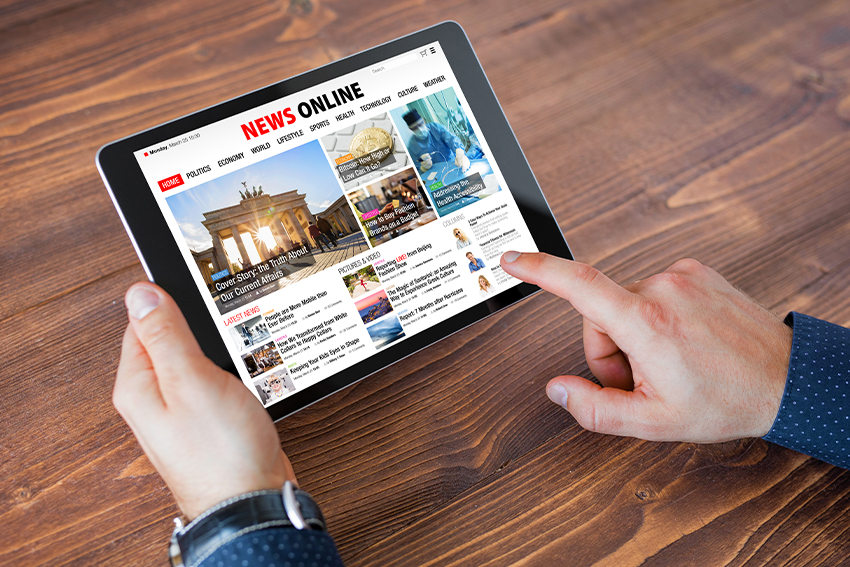The Definitive Handbook to Exploring stnews.live for Smarter News Consumption
Wiki Article
The Impact of Social Media Site on the Method We Eat News Online
Social network has fundamentally changed news intake. It supplies instant access to details, commonly eclipsing conventional media electrical outlets. Nevertheless, this quick circulation comes with obstacles. Individuals deal with the threat of running into misinformation and becoming trapped in echo chambers. The algorithms driving individualized material can obscure diverse point of views. As these dynamics evolve, comprehending their ramifications becomes important for notified interaction in public discourse. What approaches might aid navigate this complex landscape?The Development of News Intake in the Digital Age
As innovation advanced, the way people taken in news changed considerably in the electronic age (stnews.live). Standard papers and broadcast media began to decline as the internet became a key source of information. Online systems offered instant access to news posts, video clips, and podcasts, enabling individuals to stay educated at any moment. The ease of mobile phones better accelerated this change, allowing users to receive updates on the goAdditionally, the rise of news collectors and internet sites helped with the consumption of diverse viewpoints, empowering individuals to tailor their news consumption based upon personal rate of interests. This development likewise triggered news organizations to adapt their approaches, concentrating on electronic material and appealing readers via multimedia formats. Consequently, the conventional barriers of time and area in news delivery decreased, bring about an extra instant and tailored news experience for target markets worldwide.
The Role of Social Media Operatings Systems in News Circulation
Social network platforms have actually transformed news circulation by supplying instant accessibility to details. Their algorithm-driven web content curation often focuses on engagement over accuracy, resulting in significant reputation challenges (stnews.live). As individuals browse this landscape, the effects for news intake and public discussion become progressively intricateInstantaneous News Accessibility
Standard news electrical outlets have long been the key source of info, the rise of social media platforms has considerably changed how news is accessed and eaten. Instant news accessibility has actually come to be a hallmark of the electronic age, enabling customers to receive updates in real time. Systems such as Twitter, Facebook, and Instagram enable news to spread out rapidly, commonly surpassing standard media in rate and reach. Individuals can share tales, remark on events, and engage with reporters, creating a dynamic communication in between the audience and news content. This immediacy promotes a culture of urgency, motivating customers to inquire rapidly. The assumption for prompt news has actually improved journalistic practices, engaging news organizations to adapt their strategies to fulfill the demands of a fast-paced electronic environment.Algorithm-Driven Web content
While customers proactively involve with material on social media, the formulas that govern these platforms play an essential duty in identifying which news stories acquire exposure. These algorithms analyze individual habits, choices, and involvement metrics to curate individualized news feeds. As a result, particular tales might be magnified while others remain obscure, frequently focusing on mind-blowing or trending subjects over substantive coverage. This selective direct exposure shapes users' assumptions of current events and affects public discussion. Additionally, the reliance on algorithm-driven material can develop echo chambers, where customers are mostly revealed to viewpoints that align with their very own ideas. The characteristics of news distribution on social media platforms considerably affect exactly how individuals eat and interpret info in the electronic age.Reliability Challenges
As individuals progressively transform to social media sites for news, the reliability of information encountered on these systems comes to be a pressing worry. The decentralized nature of social media enables any individual to release web content, typically obscuring the lines between trustworthy journalism and false information. Formulas focus on involvement over precision, resulting in the widespread dissemination of thrilling or misleading stories. This environment positions considerable difficulties for users attempting to discern credible sources. Social media site platforms, while seeking to combat misinformation through fact-checking and material moderation, run the gauntlet for inconsistencies and biases in their approaches. Inevitably, the obligation exists with users to critically evaluate the news they consume, as the fast spread of info typically surpasses confirmation efforts by systems.The Increase of Resident Journalism and User-Generated Web Content
The rise of resident journalism has empowered everyday people to share news and viewpoints, often supplying understandings that standard media might ignore. Nevertheless, this change also offers considerable challenges, specifically the spread of misinformation that can arise from unproven web content. As user-generated web content ends up being more widespread, the balance in between authentic voices and accuracy in reporting continues to be a crucial concern.Empowering Day-to-day Voices

Difficulties of Misinformation
While the increase of resident journalism has opened methods for varied voices in the media landscape, it has actually additionally presented significant difficulties associated to false information. The convenience of sharing information with social media sites platforms allows individuals to disseminate news rapidly, but this fast spread often comes at the expense of accuracy. User-generated material often does not have the visit the website extensive fact-checking and content oversight that typical journalism gives. Sensationalized or false stories can obtain traction, misguiding target markets and forming public understanding. Moreover, the blending of opinion and fact within social media complicates the distinction between legitimate info and misinformation. As an outcome, consumers should navigate an increasingly intricate media setting, needing vital thinking skills to recognize trusted news resources in the middle of the noise
False information and Its Implications for Public Discussion
As social media platforms increasingly control the landscape of details dissemination, the spreading of false information postures significant obstacles for public discussion. False information, usually developed to misinform or provoke psychological reactions, can misshape understandings of reality and weaken count on in reliable resources. This sensation results in polarized perspectives, as people gravitate towards resemble chambers that enhance their beliefs, better entrenching divisions within society.The ramifications for public discussion are extensive. When citizens count on false info, purposeful dialogue reduces, and the autonomous procedure endures. Misinformation can prompt worry and complication, impacting public wellness, safety and security, and political stability. Therefore, fostering media proficiency comes to be crucial, empowering individuals to seriously examine info and determine truth from fiction. Attending to the difficulties postured by false information is crucial for maintaining the honesty of public discussion and making certain an educated populace qualified of taking part in constructive conversations.
The Influence of Formulas on News Presence
Provided the central role of algorithms in determining content exposure, their impact on news usage is profound. These algorithms, made use of by social networks systems, focus on specific kinds of material based on customer involvement and preferences. As an outcome, news articles that line up with preferred fads or audience rate of interests are most likely to be shown plainly, while less spectacular tales may be neglected. This develops a setting where individuals are subjected mostly to information that reinforces their perspectives, possibly causing echo chambers.Moreover, the consistent development of formulas means that news companies must adapt their approaches to align with these altering specifications, often focusing on clickbait or psychologically billed headlines. Consequently, the stability of news coverage can be endangered, as crucial tales might not get find this the presence they are worthy of. The mathematical shaping of news presence for that reason plays an important function in influencing public understanding and understanding of present occasions.
The Change Towards Aesthetic Narration in News Media
Increasingly, news media is embracing visual storytelling as a powerful tool to engage audiences. This method leverages pictures, video clips, infographics, and interactive aspects to convey details better than standard text-based layouts. As interest spans shorten, visuals use a quick, impactful means to communicate complex stories and order customers' interest.Platforms like Instagram and TikTok have further increased this pattern, engaging news companies to adapt their web content techniques to fit these visually-driven environments. By including compelling visuals, news outlets can enhance emotional connections and foster better understanding of topical concerns.
Visual storytelling permits for more diverse stories, showcasing several perspectives via dynamic presentations. As target markets progressively consume news via mobile phones, the shift towards visuals not only caters to individual choices yet likewise aids to damage down obstacles to details gain access to. Inevitably, this development mirrors a wider makeover in exactly how news is created and eaten in the digital age.
Future Trends: Browsing the Transforming Landscape of News Intake
While the digital landscape remains to develop, news intake is positioned for significant makeover driven by emerging modern technologies and changing target market behaviors. As fabricated intelligence and artificial intelligence breakthrough, customized news feeds will certainly become extra prevalent, permitting users to obtain content tailored to their passions. This customization might cause greater engagement yet likewise elevate concerns regarding resemble chambers and false information.The surge of voice-activated devices and smart speakers will influence exactly how news is provided, shifting the emphasis from aesthetic to acoustic layouts. This fad might motivate wire service to take on even more concise and engaging audio web content.

Regularly Asked Concerns
Exactly How Do Social Network Interactions Affect News Reliability?
Social network interactions can substantially affect perceptions of news credibility. Involvement metrics, such as likes and shares, often shape audience trust fund, with prominent blog posts getting perceived authenticity, regardless of the precision or integrity of the info offered.What Function Do Influencers Play in Shaping News Narratives?
Influencers greatly form news stories by leveraging their platforms to intensify specific tales, usually tailoring web content to their audience. This can bring about biased point of views, influencing public understanding and focusing on sensationalism over valid reporting.Just How Can Users Identify Reliable News Sources on Social Network?
Customers can identify trusted news sources on social networks by inspecting the resource's integrity, verifying truths via multiple electrical outlets, evaluating the professionalism and trust of the web content, and acknowledging possible biases in reporting to ensure precise details.What Influence Does Social Network Carry Traditional Journalism Jobs?
Social media considerably influences typical journalism jobs by altering profits models, minimizing need for print media, and promoting competition from Resources resident reporters. Consequently, lots of experts deal with task instability and need to adjust to quickly altering media landscapes.Exactly How Do Different Demographics Consume News on Social Media?
Various demographics exhibit diverse preferences for news consumption on social media. More youthful audiences prefer systems like TikTok and Instagram for fast updates, while older people often tend to like Twitter and facebook for a lot more thorough conversations and short articles.Report this wiki page